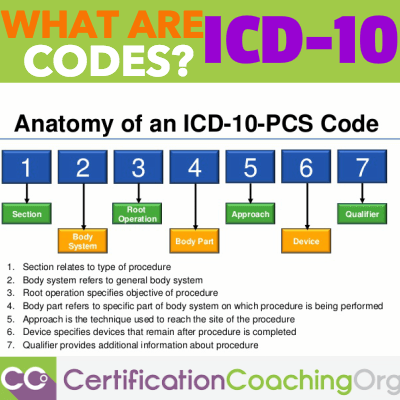 So what are ICD 10 codes? With ICD-10 already been implemented last October 1, 2015, can you now tell the difference between an ICD-9 code versus an ICD-10 code? What has been your definition so far when asked about how theya are different? What does an ICD-10 code look like? How does an ICD-10 code work? These are just a few of the many questions we will uncover in today’s post.
So what are ICD 10 codes? With ICD-10 already been implemented last October 1, 2015, can you now tell the difference between an ICD-9 code versus an ICD-10 code? What has been your definition so far when asked about how theya are different? What does an ICD-10 code look like? How does an ICD-10 code work? These are just a few of the many questions we will uncover in today’s post.
What Are ICD 10 Codes?
ICD-10 codes are alphanumeric codes used by doctors, health insurance companies, and public health agencies across the world to represent diagnoses. Every disease, disorder, injury, infection, and symptom has its own ICD-10 code. ICD-10 codes are used for everything from processing health insurance claims to tracking disease epidemics and compiling worldwide mortality statistics. Source: http://healthinsurance.about.com/od/claims/fl/What-Are-ICD-10-Codes-amp-How-Do-They-Work.htm
What Does an ICD-10 Code Look Like?
ICD-10 codes are approached differently and are quite different from their ICD-9 counterparts. These codes are broken down into chapters and subchapters. They are comprised of a letter plus two digits to the left of the decimal point, then one digit to the right. The letters group diseases. All codes preceded by a C indicate a malignancy (cancer), codes preceded by a K indicate gastrointestinal problems, and so forth.
Examples are:
- A02.0 indicates a salmonella infection
- I21.X refers to myocardial infarction
- M16.1 is used for arthritis in the hip
- Q codes represent genetic abnormalities, like Q35 for a baby born with a cleft palate
- U codes are for new problems that develop over time. Any of the antibiotic resistant “superbugs” that develop over time will fall into the U category.
Source: http://patients.about.com/od/medicalcodes/a/findicdcode.htm
ICD-10-CM Official Guidelines for Medical Coding Reporting

Major Differences Between ICD-9 and ICD-10
ICD-9 Diagnosis Codes
- 3 to 5 digits
- First digit is alpha or numeric
- Digits 2 thru 5 are numeric
- Limited space for adding new codes
- Lacks detail
- Includes approximately 17,000 codes
ICD-10 Diagnosis Codes
- 3 to 7 digits
- Digit 1 is alpha
- Digit 2 is numeric
- Digits 3 thru 7 are alpha or numeric
- Flexibility allows the addition of new codes
- Very specific
- Includes nearly 160,000 codes
Source: http://medicaloffice.about.com/od/coding/tp/5-Things-To-Know-About-Icd-10.htm
How Does an ICD-10 Code Work?
Each code in a given ICD-10 code describes a particular diagnosis in detail. Here’s an example of some of the ICD-10-CM codes used to describe diagnoses of rheumatoid arthritis. Notice how characters are added to the ICD-10-CM code as the diagnosis gets more specific.
| ICD-10-CM Code | Diagnosis |
| M05.7 | Rheumatoid arthritis with rheumatoid factor without organ or systems involvement |
| M05.73 | Rheumatoid arthritis with rheumatoid factor of the wrist without organ or systems involvement |
| M05.732 | Rheumatoid arthritis with rheumatoid factor of the left wrist without organ or systems involvement |
| M06.0 | Rheumatoid arthritis without rheumatoid factor |
| M06.03 | Rheumatoid arthritis without rheumatoid factor of the wrist |
| M06.032 | Rheumatoid arthritis without rheumatoid factor of the left wrist |
| M06.031 | Rheumatoid arthritis without rheumatoid factor of the right wrist |
- The first 3 characters define the category of the disease, disorder, infection or symptom. For example, codes starting with M00-M99 are for diseases of the musculoskeletal system and connective tissue (like rheumatoid arthritis), while codes starting with J00-J99 are for diseases of the respiratory system.
- Characters in positions 4-6 define the body site, severity of the problem, cause of the injury or disease, and other clinical details. In the rheumatoid arthritis example above, the fifth character defines the body site and the sixth character defines whether it’s the left or right side. A three in the fifth character position denotes it’s a wrist that’s affected. A two in the sixth character position denotes it’s the left side of the body that’s affected.
- Character 7 is an extension character used for varied purposes such as defining whether this is the initial encounter for this problem, a subsequent encounter, or sequela arising as a result of another condition.
Source: http://healthinsurance.about.com/od/claims/fl/What-Are-ICD-10-Codes-amp-How-Do-They-Work.htm
Find lists of ICD-10 codes online:
- The master list of ICD-10 codes can be found on the WHO website. It is searchable.
- Another searchable list of ICD-10 codes here.
Related What Are ICD 10 Codes Post:
- How ICD-10 Transition Will Benefit Your Practice
- The ICD-10 Transition — How’s ICD-10 After Day 60?
- 20 Amusing and Bizzarre New ICD-10 Codes!
![[CCO] Certification Coaching Organization LLC [CCO] Certification Coaching Organization LLC](https://www.cco.us/wp-content/uploads/2015/05/CCO-Logo-2015-d3-500px.png)
OMG I luv this and i has been so very helpful,
Thanks and Giant Bigs Hugs to Pinterest
Glad you found it helpful.
CCO Has many Pinterest boards.
You should consider joining the CCO Community free forum for more great resources.
https://www.cco.us/cco-free-forum/